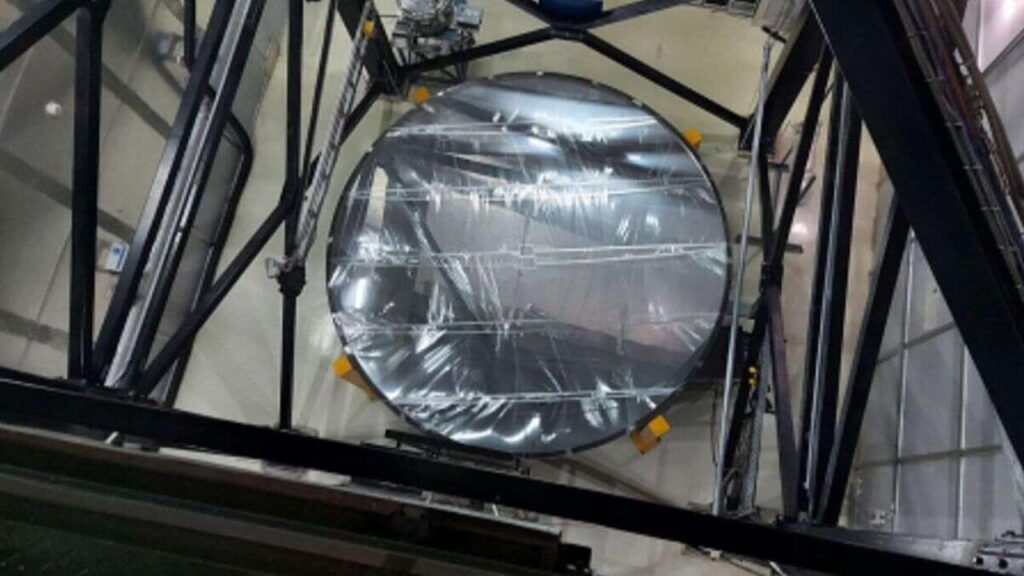International Liquid Mirror Telescope: The world’s largest liquid mirror telescope has been commissioned in India, which is expected to help observe transient and diffuse astronomical phenomena more cost-effectively. Scientists from India, Belgium, and Canada built the instrument, which will be housed in Devasthal Observatory of the Aryabhatta Research Institute of Observational Sciences in Nainital, Uttarakhand, India at an altitude of 2450 meters. Starting October this year, the International Liquid Mirror Telescope (ILMT) will gaze at the stars every night for a period of five years except for the months of July and August to prevent moisture damage to the device.
Check James Webb Space Telescope First Image
Why it is called Liquid Mirror Telescope?
The reflective surface of the 4m International Liquid Mirror Telescope is made of mercury, which is liquid at room temperature. Due to the rotational forces, the liquid metal is rotated along the axis of the telescope and takes on a parabolic shape, which is exactly what it takes to focus light. The rays of light that arrive parallel to the telescope’s center of rotation are sharply focused, but those coming from other directions are not sharply focused, but that is corrected with added lenses, resulting in good image quality. This ILMT at Devasthal observatory measures 4 meters in diameter.
Check Lunar and Solar Eclipse Calendar Here!
How International Liquid Mirror Telescope is better than conventional telescopes?
Let’s now be aware of how the International Liquid Mirror Telescope of India is a great alternative to traditional telescopes. The images of conventional telescopes are focused on using glass mirrors. Even larger telescopes use segmented mirrors. These require careful manufacturing – they must be ground and polished carefully before being coated with a fine layer of Aluminium or Silver.
Know About Extraterrestrial Photosynthesis Here!
Temperature changes and the influence of gravity can distort the shape of these instruments, which in turn distorts the images that can be captured. As a matter of fact, most large, modern telescopes use sensors to maintain their mirror shape. Such technology, however, requires tremendous capital investments.
Liquid mirror telescopes, which rotate a mercury-covered dish, are a more sustainable option. The liquid mirror telescope, an old idea (first mentioned in print in 1850), has been improved by technology so that image quality has not been compromised.
Check List of Things Named After Einstein Here!
Drawback of World’s First Liquid Mirror Telescopes
The liquid mirror telescope lacks flexibility, which is one of its potential downsides. In contrast, conventional telescopes can be pointed anywhere to observe specific objects or formations, while the rotating liquid telescope can only point straight up.
However, this lack of flexibility is not so problematic considering that the zenith is the best location to make observations (because there is the least resistance from the atmosphere). As well, when astronomers make statistical observations, for example, how many galaxies or asteroids are present, viewing any part of the sky does the job. Because liquid mirror telescopes are far less expensive to build than conventional ones, they can be used in such studies.
Know Some Cool Idioms on Science and Technology Here!
Installing a telescope on the Moon – Way ahead!
Researchers have dreamed of a telescope on the moon for decades. Lunar Crater Radio Telescope project was awarded $500,000 by NASA in April 2021. Due to the absence of an atmosphere, a telescope on the moon could observe longer radio wavelengths. Scientists could cut through the noise and peer into space like never before if a telescope were built on the dark side of the moon to block radio chatter from Earth.
Since the moon has a stable gravity and has no atmosphere, the international liquid mirror telescope is also an ideal candidate for a moon observatory. On the moon, mercury cannot be used since it would freeze, however, other ionic liquids that do not evaporate can be used to make reflective surfaces.
We hope this article on International Liquid Mirror Telescope UPSC was helpful for you, below are the frequently asked questions about the ILMT, those who would like to know more interesting Science and Tech news like this can check Studiously Yours blog daily.
Reference – 4mILMT
International Liquid Mirror Telescope -FAQs
The world’s first Liquid Mirror Telescope is going to be installed in the Devasthal Observatory at Aryabhatta Research Institute of Observational Sciences in Nainital, India.
Mercury has been used in this Liquid Mirror Telescope.
The Mercury will work as a reflective surface.
Yes, the Liquid Mirror Telescope is a cost-effective alternative to the traditional telescopes.
Yes, the IMLT is not as flexible as large conventional telescopes which can be pointed out in any direction.
